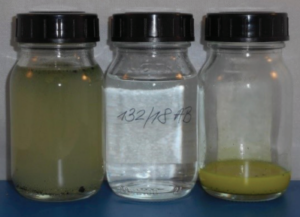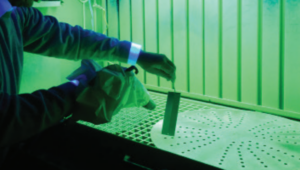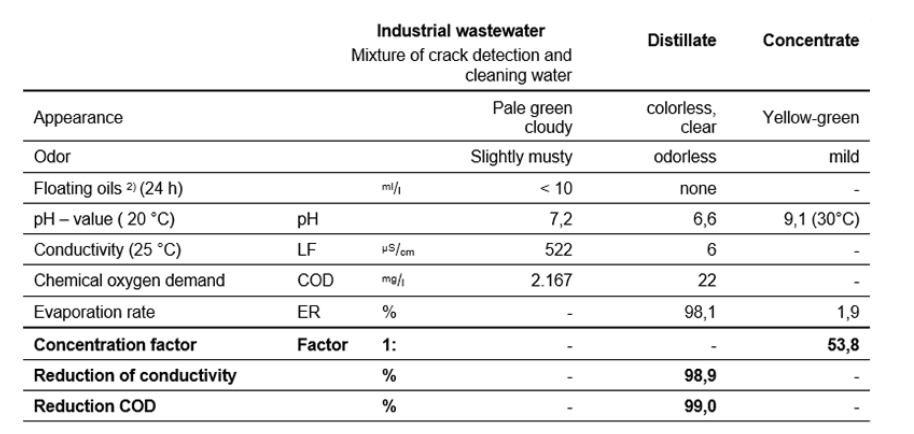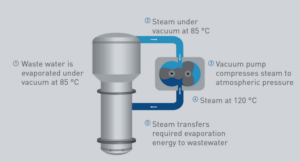Save 250,000 Euro per year: Treat process water of aviation sustainably

Save 250,000 Euro per year: Treat process water of aviation sustainably
The topic of sustainability is currently gaining more and more importance due to the increasing environmental awareness in the industry. Especially in aviation, the focus is on an environmentally friendly, sustainable air traffic system. Here, the VACUDEST technology offers an intelligent solution that is both sustainable and economical: wastewater-free production. Ecological sustainability means the conservation of natural resources, the increase of energy efficiency and the reduction of pollutant emissions. New demands are also being placed on maintenance service providers from the “MRO industry“ (maintenance, repair, overhauling). They are responsible for the maintenance, repair and overhaul of components and accompany an aircraft over the longest period of its life cycle.
The use of a VACUDEST vacuum distillation system makes an important contribution to meeting these new requirements. This technology enables a recirculation of the treated process water and is also enormously efficient due to cost savings in various areas. A look into the production illustrates these advantages: During component cleaning, galvanic coating processes and crack detection, a wide variety of process waters are produced in the aviation industry, which have to be disposed of at high costs. The VACUDEST vacuum distillation system can efficiently treat both individual streams and mixtures of these different process waters. The distillate can be recirculated and thus recycled in many application examples. This reduces the environmental impact enormously. Due to the drastic reduction of disposal costs, the annual savings potential is also very high.

Excursus: crack detection
By means of dye penetrant methods, surface defects in metallic materials can be detected very quickly on components. This method is mainly used for the inspection of welds and components in the maritime, aviation and automotive industries as well as in apparatus and container construction. A distinction is made between colored and fluorescent penetrant inspection. The fluorescent inspection, which is particularly common in the aviation industry for safety-relevant parts, is carried out under UV light with fluorescent penetrant. Defects such as cracks can thus be easily detected without the component being damaged or destroyed during the inspection. The increasing quality standards in the aviation industry require this type of material testing.

Best distillate quality through patented Clearcat technology
The principle of vacuum distillation is an excellent method for the treatment of wastewater containing oil. This also includes process water, such as crack detection, cleaning and degreasing water, which is produced in the aviation industry. In the past, vacuum evaporators were able to separate salts and heavy metals reliably, but over-distillating hydrocarbons and oil components caused problems. These impurities had to be laboriously separated by additional process steps. he Clearcat technology enables a COD reduction of over 98 percent. The patented Clearcat technology reliably separates these organic contaminants while still in the plant and significantly improves the distillate quality – the distillate is crystal clear and oil-free. A very low hydrocarbon index can be guaranteed. The COD value (chemical oxygen demand) caused by oils, a measure of the organic pollution of the water, is reduced by up to 98 percent. This represents an improvement of 60 percent compared to single-stage distillation. In the process water analysis that follows, this reduction is even exceeded.

Circulation with VACUDEST in the MRO industry
A sample from an MRO company examined in the laboratory shows that the process water treated with VACUDEST can be recirculated and thus reused in production. Also a discharge into the sewer is possible in any case, since the distillate meets the qualitative requirements of the authorities. In the case study the examined mixture of crack test and cleaning water can even be concentrated up to a remainder of only less than 2 per cent. Measured against a total amount of process water of 3,000 cubic meters per year, this corresponds to only about 60 cubic meters. Accordingly, around 2,940 cubic meters can be sustainably recycled. Physically, 99.9 percent of the heavy metals are separated, so that the discharge limits for heavy metals are reliably met. A good indication of the presence of salts is the conductivity. This was determined in the case study with only 6 µS/cm. The distillate is therefore salt-free. The other measured parameters also allow the distillate to be reused directly in the production process. Besides the low conductivity, the COD value is also greatly reduced. The almost pH-neutral distillate is therefore ideally suited for reuse in various production processes. In this way, costs can be reduced by 98 percent: On the left, process water from aviation, in the middle the treated distillate by a VACUDEST system with Clearcat, on the right the minimized concentrate. Vacuum distillation using VACUDEST is a sustainable and efficient solution for wastewater treatment in the aviation industry. The distillate meets the strict quality requirements of the aviation industry. Depending on the specific requirements of the customers, the distillate quality can be further optimized by using downstream technologies such as ion exchangers or UV treatment.
Case Study 2

Another MRO company goes wastewater-free!
Jet Aviation in Basel, Switzerland, is using a VACUDEST vacuum distillation system to efficiently and sustainably treat wastewater left over from refurbishing aircraft parts. This state-of-the-art system replaced outdate chemical-physical treatment at the company. Jet Aviation is particularly pleased with the high quality of the treated water, which can even be reused in maintenance processes. This allows the company to conserve freshwater resources and make a valuable contribution to protecting the environment.
- Wheel Shop (aircraft wheel refurbishing)
- Engine Shop (turbine refurbishing)
- Non Destructive Testing
Jet Aviation supplies aircraft interiors from its Basel location, where the company maintains its own joinery, saddlery and tinsmith’s, painting and fibreglass workshops. The company also focuses on maintenance, repair and refurbishing (MRO) work for aircraft. Jet Aviation performs maintenance work on business and private jets and also services standard business aircraft jet engines. The following three departments produce heavily charged wastewater that cannot be simply discharged into sewerage systems:

The Wheel Shop is chiefly responsible for inspecting aircraft wheel rims to detect cracks and corrosion. Prior to these inspections, the soiled aircraft wheel rims are cleaned in an ultrasonic bath with special alkaline cleaning chemicals in order to remove impurities. The wheel rims also need to be blasted with plastic granulate to remove all paint. Afterwards, all of the wheel rims are washed with distilled water and prepared for crack testing. Various different jet engines and auxiliary power units (APUs) are refurbished in the Engine Shop. The jet engines and APUs need to be disassembled from one another and broken down into their individual parts. The soiled individual parts are then cleaned with alkaline cleaning agents in ultrasonic baths. The Non-Destructive Testing department submits the most important aircraft parts, engine parts and aircraft wheel rims to crack testing. This work step involves using an oily fluorescent penetrating agent. All of the parts that need to be tested are sprayed with fluorescent test oil across their entire surfaces. After the oil has been allowed to sink in for a certain period of time, it needs to be washed off of these surfaces. The wastewater left over from the processes described above contains many impurities, such as oil, dust, particles and heavy metals and cannot simply be discharged into sewerage systems.

Initial situation
In the past, the ultrasonic washing water from the Wheel Shop and Turbine Shop as well as the crack testing water were treated using large activated carbon cartridges and then discharged into sewerage systems. “This method required a great deal of supervision – the activated carbon needed to be switched out and disposed of very frequently,” explains Jürgen Lindgens, Manager of the Non-Destructive Testing department at Jet Aviation. Lindgens is responsible for wastewater treatment in this department, among other things. Moreover, the required limits were not always met, in which cases the cleaned water could not be discharged and had to be picked up by waste management facilities: a costly task. “As a state-of-the-art company, we were dissatisfied with that situation, so we went off in pursuit of more reliable technology,” Lindgens continues. Lindgens and his team learned of H2O and VACUDEST vacuum distillation technology through numerous recommendations from fellow MRO companies.

An economical solution thanks to low energy consumption
VACUDEST vacuum distillation systems allow impurities contained in wastewater, such as oils, salts and heavy metals, to be separated from clean water through evaporation. Since the system directly uses the energy generated during steam condensation for evaporation, the level of energy consumption is very low and the system operates in a very economical
manner. Intrigued by this prospect, Jet Aviation held project discussions on site at EuroAirport Basel Mulhouse Freiburg. Once the offer had been inspected and approved, H2O received an order for a turnkey solution. Alongside the VACUDEST XS 180 vacuum distillation system, this solution also included all of the relevant accessories:
VACUDEST enables recycling
Ever since the complete system was installed, the VACUDEST XS 180 has been treating 180 m³ of wastewater annually and creating clean distillate that can be directly reused in washing processes after simple post-processing with an ion exchange cartridge. This ensures that the water from the relevant water flows no longer needs to be discharged or removed and that the applicable limits cannot be exceeded. Jet Aviation is now wastewater-free. Project Leader Jürgen
Lindgens is very happy about this, and confirms: “I am very pleased – ever since the VACUDEST was installed I haven’t had to work with disposal authorities anymore.”
The VACUDEST is 100 per cent automatic and distinguished by its low maintenance costs. This allows Jet Aviation to focus on its core business: maintaining and refurbishing turbines and aircraft wheels.
- 2 m³ industrial wastewater collection tank
- Two automatic rinsing systems for VACUDEST with
- alkaline and acidic cleaners (VacuCIP)
- Residual oil separator to ensure the highest
- level of quality in cleaned wastewater (Activedest)
- 2 m³ collection tank for the cleaned wastewater
- 1 m³ collection tank for the concentrated residues
- Piping and cabling for all components
- Commissioning and operator training
